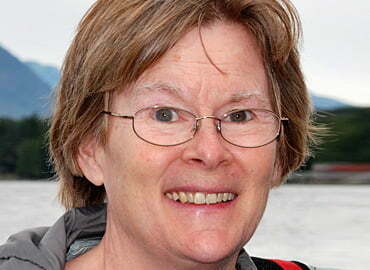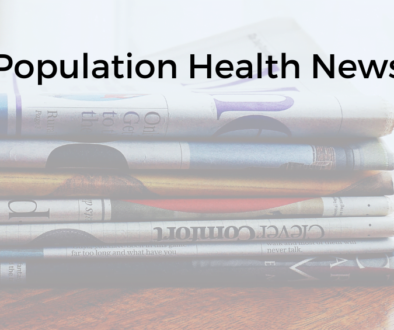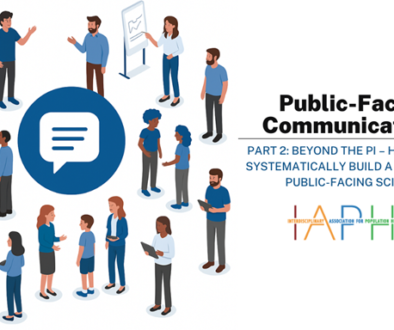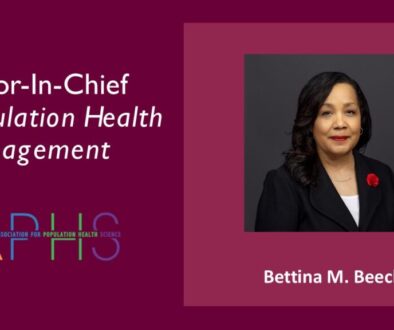Values and Science – Embracing Differences: Towards the Big Tent Ideal
Christine BachrachWhat makes an organization like IAPHS successful?
Since its inception, IAPHS has identified itself as a Big Tent organization — an organization that welcomes all kinds of diversity in its membership. “All kinds of diversity,” however, implies differences, differences that may complicate the task of developing shared understandings of organizational identity and purpose that hold an organization together.
This is the final post in the Values & Science Blog series. In previous posts, we’ve explored how beliefs about what is important to us and to society as a whole can affect our research, influencing the questions that we ask (and choose not to ask), as well as our theories and concepts, methods and measures, and interpretations of results. We’ve explored different ways of thinking about the relationships between values and science and whether value-free science is possible or even desirable. We have also asked whether the disproportionately liberal and progressive views of population health scientists narrow our science or erode its credibility when working with communities and policymakers who don’t share our views. (The full series is available at the following links: Part 1, Part 2, Part 3, Part 4, Part 5, Part 6 and Part 7).
An Abundance of Differences
In interviews for the series, we discovered that population health scientists have a wide range of opinions about these issues. At a Town Hall session at the 2023 IAPHS Conference in which participants discussed the meaning of population health science itself, a diversity of perspectives also emerged. (You can read a summary of the session here). We found differences on multiple fronts, including:
- Does the field of population health science necessarily encompass a mission to improve health and health equity, and not just a goal to understand how health and its distribution across populations arise? Some IAPHS members emphasized a focus on equity and justice as inherent in population health science, while others argued for a definition of the field that focused primarily on scientific goals.
- Should population health researchers strive to produce work that is as value-free as possible, or should they embrace the influence of personal values on their work as a positive good while disclosing their values to their audiences?
- Would population health research on politically divisive issues be stronger if it engaged more people with conservative views?
In many of our conversations, IAPHS members indicated that they assumed that other population health scientists felt the same way they did, both about the personal values that motivate their work and about how those values should affect their research. This assumption of sameness, backed by a conviction that we all think the right way, risks creating a culture in which people who do not share the dominant views can feel unwelcome or silenced. This, too, came out clearly in our conversations (see Part 6). Some people reported that they avoided coming to conferences, felt they could not express ideas that might be viewed as politically incorrect, and would put themselves at risk by reporting research findings that contradicted dominant narratives. How does this align with IAPHS’s Big Tent identity?
The Big Tent
In a 2020 vision statement, the IAPHS Board called for welcoming members who differ on many dimensions, including discipline, life experience, race, ethnicity, gender expression, and political and cultural values. The value of such a Big-Tent vision for IAPHS is clear: A multi-level understanding of the causes of health across populations depends on contributions from people representing a broad expanse of expertise and experience. But a Big Tent vision also is vitally important because of how values and science intersect. Because values affect the work of individual scientists, it falls to the scientific community to create a body of knowledge capable of transcending individual values. Key requirements for doing this include ensuring that members of the community offer a diversity of perspectives and encouraging productive debate about them (for more on this, read Part 4 of the series).
A Big Tent organization needs to do two things. First, it needs to achieve the needed diversity in its membership. In other words, it needs to make the Big Tent a reality and not just a wished-for ideal. Second, it needs to recognize, honor, and accommodate differences under the tent while cultivating elements of common ground needed to facilitate cross-fertilization across members with different kinds of expertise, experience, and values.
Although IAPHS has a diverse membership on some dimensions, it has not yet achieved its vision for including members with a diversity of political values. As we discussed in Part 5, IAPHS members predominantly hold liberal or progressive views on issues like inequality, reproductive rights, public health policy, and other issues we typically study.
On the other hand, this Blog series has shown that the IAPHS membership is very diverse on another dimension — values about how ideological or political beliefs can and should influence science. This diversity can make it more difficult to resolve issues about what IAPHS does or aspires to be. For example:
- Should IAPHS aspire to bring people with conservative values under its tent? The IAPHS members we interviewed disagreed on whether the lack of such voices matters for our science.
- Should IAPHS identify itself as an advocate for population health and health equity and take positions on policies and practices that we believe will further those ends? Or should it maintain neutrality on these issues as a scientific organization? Again, IAPHS members disagree (see the Town Hall Summary).
And that’s where the second challenge for a Big Tent organization comes in. The various scientific, personal, experiential, and political values we’ve explored in this Blog series are deeply held and are often backed by moral certitude. But if we are to remain a Big Tent, they need, at a minimum, to co-exist.
Surfacing and acknowledging our differences is a critical first step. Developing mechanisms, transparent to and trusted by the membership, to address disagreements and find compromises on key issues is another step. Perhaps the most important step is to find ways to put differences to constructive use. Differences, after all, are why we want a Big Tent in the first place — to learn from each other, to explore the merits of different ideas, and to spark creativity in our science. These worthy outcomes depend, however, on whether a Big Tent organization can provide mechanisms that foster a high level of open, frank, and respectful exchange among its members.
As an organization, IAPHS seeks to advance the best possible knowledge to understand population health and inform population health action. It needs a Big Tent to do it. This series has raised issues and questions but does not presume to offer answers. For these, we urge the leaders and members of IAPHS to pick up where we left off in considering what kind of Big-Tent organization IAPHS should be, and what it can do to achieve its vision.
About the Author: Christine Bachrach is a co-Founder of IAPHS and served as its Executive Director and Senior Advisor. She is the organizer of this series and accepts full responsibility for its content as a representation of the authors’ thoughts and opinions and not necessarily the opinion of IAPHS as an organization. This final post was greatly improved through comments from Erika Blacksher, Kathie Harris, Jennifer Karas Montez, Sanne Magnan, Jarron Saint Onge, and Anna Zajacova. Many others contributed to the series in other ways: Yukiko Asada, Caryn Bell, Merlin Chowkwanyun, Jen Cruz, Kaori Fujishiro, Sandro Galea, Taylor Hargrove, Nicholas King, Lindsey Leininger, Megan Reynolds, Brooke Staley, Kat Theall, Alex Tsai, and Anna Zajacova. Dr. Bachrach is grateful to them all.






All comments will be reviewed and posted if substantive and of general interest to IAPHS readers.